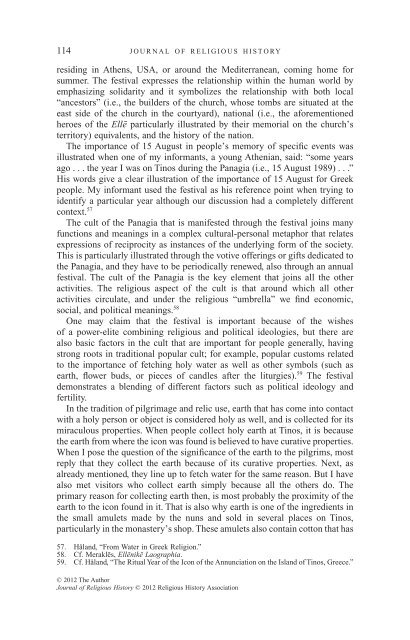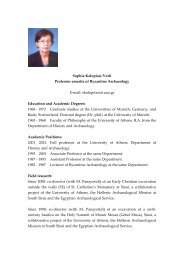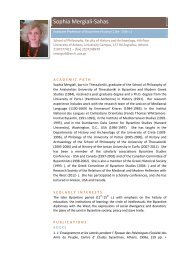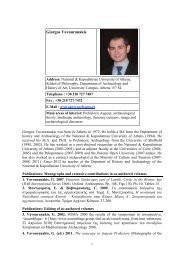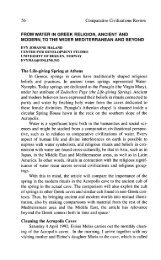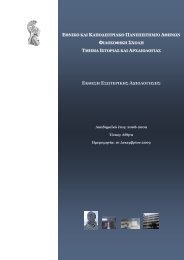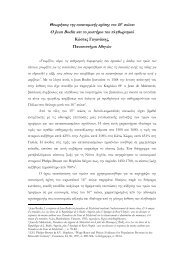The Dormition of the Virgin Mary on the Island of Tinos: A ...
The Dormition of the Virgin Mary on the Island of Tinos: A ...
The Dormition of the Virgin Mary on the Island of Tinos: A ...
You also want an ePaper? Increase the reach of your titles
YUMPU automatically turns print PDFs into web optimized ePapers that Google loves.
114 JOURNAL OF RELIGIOUS HISTORY<br />
residing in A<str<strong>on</strong>g>the</str<strong>on</strong>g>ns, USA, or around <str<strong>on</strong>g>the</str<strong>on</strong>g> Mediterranean, coming home for<br />
summer. <str<strong>on</strong>g>The</str<strong>on</strong>g> festival expresses <str<strong>on</strong>g>the</str<strong>on</strong>g> relati<strong>on</strong>ship within <str<strong>on</strong>g>the</str<strong>on</strong>g> human world by<br />
emphasizing solidarity and it symbolizes <str<strong>on</strong>g>the</str<strong>on</strong>g> relati<strong>on</strong>ship with both local<br />
“ancestors” (i.e., <str<strong>on</strong>g>the</str<strong>on</strong>g> builders <str<strong>on</strong>g>of</str<strong>on</strong>g> <str<strong>on</strong>g>the</str<strong>on</strong>g> church, whose tombs are situated at <str<strong>on</strong>g>the</str<strong>on</strong>g><br />
east side <str<strong>on</strong>g>of</str<strong>on</strong>g> <str<strong>on</strong>g>the</str<strong>on</strong>g> church in <str<strong>on</strong>g>the</str<strong>on</strong>g> courtyard), nati<strong>on</strong>al (i.e., <str<strong>on</strong>g>the</str<strong>on</strong>g> aforementi<strong>on</strong>ed<br />
heroes <str<strong>on</strong>g>of</str<strong>on</strong>g> <str<strong>on</strong>g>the</str<strong>on</strong>g> Ellē particularly illustrated by <str<strong>on</strong>g>the</str<strong>on</strong>g>ir memorial <strong>on</strong> <str<strong>on</strong>g>the</str<strong>on</strong>g> church’s<br />
territory) equivalents, and <str<strong>on</strong>g>the</str<strong>on</strong>g> history <str<strong>on</strong>g>of</str<strong>on</strong>g> <str<strong>on</strong>g>the</str<strong>on</strong>g> nati<strong>on</strong>.<br />
<str<strong>on</strong>g>The</str<strong>on</strong>g> importance <str<strong>on</strong>g>of</str<strong>on</strong>g> 15 August in people’s memory <str<strong>on</strong>g>of</str<strong>on</strong>g> specific events was<br />
illustrated when <strong>on</strong>e <str<strong>on</strong>g>of</str<strong>on</strong>g> my informants, a young A<str<strong>on</strong>g>the</str<strong>on</strong>g>nian, said: “some years<br />
ago...<str<strong>on</strong>g>the</str<strong>on</strong>g>yearIwas<strong>on</strong><strong>Tinos</strong> during <str<strong>on</strong>g>the</str<strong>on</strong>g> Panagia (i.e., 15 August 1989) ...”<br />
His words give a clear illustrati<strong>on</strong> <str<strong>on</strong>g>of</str<strong>on</strong>g> <str<strong>on</strong>g>the</str<strong>on</strong>g> importance <str<strong>on</strong>g>of</str<strong>on</strong>g> 15 August for Greek<br />
people. My informant used <str<strong>on</strong>g>the</str<strong>on</strong>g> festival as his reference point when trying to<br />
identify a particular year although our discussi<strong>on</strong> had a completely different<br />
c<strong>on</strong>text. 57<br />
<str<strong>on</strong>g>The</str<strong>on</strong>g> cult <str<strong>on</strong>g>of</str<strong>on</strong>g> <str<strong>on</strong>g>the</str<strong>on</strong>g> Panagia that is manifested through <str<strong>on</strong>g>the</str<strong>on</strong>g> festival joins many<br />
functi<strong>on</strong>s and meanings in a complex cultural-pers<strong>on</strong>al metaphor that relates<br />
expressi<strong>on</strong>s <str<strong>on</strong>g>of</str<strong>on</strong>g> reciprocity as instances <str<strong>on</strong>g>of</str<strong>on</strong>g> <str<strong>on</strong>g>the</str<strong>on</strong>g> underlying form <str<strong>on</strong>g>of</str<strong>on</strong>g> <str<strong>on</strong>g>the</str<strong>on</strong>g> society.<br />
This is particularly illustrated through <str<strong>on</strong>g>the</str<strong>on</strong>g> votive <str<strong>on</strong>g>of</str<strong>on</strong>g>ferings or gifts dedicated to<br />
<str<strong>on</strong>g>the</str<strong>on</strong>g> Panagia, and <str<strong>on</strong>g>the</str<strong>on</strong>g>y have to be periodically renewed, also through an annual<br />
festival. <str<strong>on</strong>g>The</str<strong>on</strong>g> cult <str<strong>on</strong>g>of</str<strong>on</strong>g> <str<strong>on</strong>g>the</str<strong>on</strong>g> Panagia is <str<strong>on</strong>g>the</str<strong>on</strong>g> key element that joins all <str<strong>on</strong>g>the</str<strong>on</strong>g> o<str<strong>on</strong>g>the</str<strong>on</strong>g>r<br />
activities. <str<strong>on</strong>g>The</str<strong>on</strong>g> religious aspect <str<strong>on</strong>g>of</str<strong>on</strong>g> <str<strong>on</strong>g>the</str<strong>on</strong>g> cult is that around which all o<str<strong>on</strong>g>the</str<strong>on</strong>g>r<br />
activities circulate, and under <str<strong>on</strong>g>the</str<strong>on</strong>g> religious “umbrella” we find ec<strong>on</strong>omic,<br />
social, and political meanings. 58<br />
One may claim that <str<strong>on</strong>g>the</str<strong>on</strong>g> festival is important because <str<strong>on</strong>g>of</str<strong>on</strong>g> <str<strong>on</strong>g>the</str<strong>on</strong>g> wishes<br />
<str<strong>on</strong>g>of</str<strong>on</strong>g> a power-elite combining religious and political ideologies, but <str<strong>on</strong>g>the</str<strong>on</strong>g>re are<br />
also basic factors in <str<strong>on</strong>g>the</str<strong>on</strong>g> cult that are important for people generally, having<br />
str<strong>on</strong>g roots in traditi<strong>on</strong>al popular cult; for example, popular customs related<br />
to <str<strong>on</strong>g>the</str<strong>on</strong>g> importance <str<strong>on</strong>g>of</str<strong>on</strong>g> fetching holy water as well as o<str<strong>on</strong>g>the</str<strong>on</strong>g>r symbols (such as<br />
earth, flower buds, or pieces <str<strong>on</strong>g>of</str<strong>on</strong>g> candles after <str<strong>on</strong>g>the</str<strong>on</strong>g> liturgies). 59 <str<strong>on</strong>g>The</str<strong>on</strong>g> festival<br />
dem<strong>on</strong>strates a blending <str<strong>on</strong>g>of</str<strong>on</strong>g> different factors such as political ideology and<br />
fertility.<br />
In <str<strong>on</strong>g>the</str<strong>on</strong>g> traditi<strong>on</strong> <str<strong>on</strong>g>of</str<strong>on</strong>g> pilgrimage and relic use, earth that has come into c<strong>on</strong>tact<br />
with a holy pers<strong>on</strong> or object is c<strong>on</strong>sidered holy as well, and is collected for its<br />
miraculous properties. When people collect holy earth at <strong>Tinos</strong>, it is because<br />
<str<strong>on</strong>g>the</str<strong>on</strong>g> earth from where <str<strong>on</strong>g>the</str<strong>on</strong>g> ic<strong>on</strong> was found is believed to have curative properties.<br />
When I pose <str<strong>on</strong>g>the</str<strong>on</strong>g> questi<strong>on</strong> <str<strong>on</strong>g>of</str<strong>on</strong>g> <str<strong>on</strong>g>the</str<strong>on</strong>g> significance <str<strong>on</strong>g>of</str<strong>on</strong>g> <str<strong>on</strong>g>the</str<strong>on</strong>g> earth to <str<strong>on</strong>g>the</str<strong>on</strong>g> pilgrims, most<br />
reply that <str<strong>on</strong>g>the</str<strong>on</strong>g>y collect <str<strong>on</strong>g>the</str<strong>on</strong>g> earth because <str<strong>on</strong>g>of</str<strong>on</strong>g> its curative properties. Next, as<br />
already menti<strong>on</strong>ed, <str<strong>on</strong>g>the</str<strong>on</strong>g>y line up to fetch water for <str<strong>on</strong>g>the</str<strong>on</strong>g> same reas<strong>on</strong>. But I have<br />
also met visitors who collect earth simply because all <str<strong>on</strong>g>the</str<strong>on</strong>g> o<str<strong>on</strong>g>the</str<strong>on</strong>g>rs do. <str<strong>on</strong>g>The</str<strong>on</strong>g><br />
primary reas<strong>on</strong> for collecting earth <str<strong>on</strong>g>the</str<strong>on</strong>g>n, is most probably <str<strong>on</strong>g>the</str<strong>on</strong>g> proximity <str<strong>on</strong>g>of</str<strong>on</strong>g> <str<strong>on</strong>g>the</str<strong>on</strong>g><br />
earth to <str<strong>on</strong>g>the</str<strong>on</strong>g> ic<strong>on</strong> found in it. That is also why earth is <strong>on</strong>e <str<strong>on</strong>g>of</str<strong>on</strong>g> <str<strong>on</strong>g>the</str<strong>on</strong>g> ingredients in<br />
<str<strong>on</strong>g>the</str<strong>on</strong>g> small amulets made by <str<strong>on</strong>g>the</str<strong>on</strong>g> nuns and sold in several places <strong>on</strong> <strong>Tinos</strong>,<br />
particularly in <str<strong>on</strong>g>the</str<strong>on</strong>g> m<strong>on</strong>astery’s shop. <str<strong>on</strong>g>The</str<strong>on</strong>g>se amulets also c<strong>on</strong>tain cott<strong>on</strong> that has<br />
57. Håland, “From Water in Greek Religi<strong>on</strong>.”<br />
58. Cf. Meraklēs, Ellēnikē Laographia.<br />
59. Cf. Håland, “<str<strong>on</strong>g>The</str<strong>on</strong>g> Ritual Year <str<strong>on</strong>g>of</str<strong>on</strong>g> <str<strong>on</strong>g>the</str<strong>on</strong>g> Ic<strong>on</strong> <str<strong>on</strong>g>of</str<strong>on</strong>g> <str<strong>on</strong>g>the</str<strong>on</strong>g> Annunciati<strong>on</strong> <strong>on</strong> <str<strong>on</strong>g>the</str<strong>on</strong>g> <strong>Island</strong> <str<strong>on</strong>g>of</str<strong>on</strong>g> <strong>Tinos</strong>, Greece.”<br />
© 2012 <str<strong>on</strong>g>The</str<strong>on</strong>g> Author<br />
Journal <str<strong>on</strong>g>of</str<strong>on</strong>g> Religious History © 2012 Religious History Associati<strong>on</strong>


